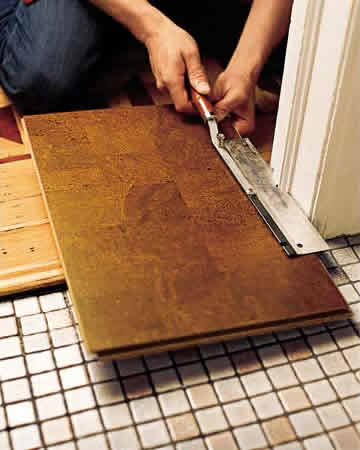Have you fallen in love with the warmth and natural beauty of cork flooring but are staring down a sea of existing tile in your home? You might be wondering, “Can I install cork flooring over tile?” The answer is a qualified yes, but it’s not as straightforward as laying a new rug. This intriguing project requires careful consideration and a few key steps to ensure a successful outcome.

Image: cinvex.us
Installing cork over tile opens a world of possibilities for home renovation. It allows you to transform a space without the hassle of completely removing the existing tile. Cork flooring offers a unique combination of benefits, including warmth, noise reduction, cushioning, and sustainability. But before you dive in, it’s crucial to understand the nuances and potential challenges of this project.
Understanding the Challenges: Tile and the Underlayment
The success of installing cork flooring over tile hinges on the condition of your existing tile and the suitability of its underlayment. Here’s what you need to consider:
1. The Condition of the Tile:
- Stability: Tile flooring must be firmly attached to the subfloor. Loose or cracked tiles can cause problems with the cork flooring’s stability and appearance. If your tile is loose or damaged, it’s best to address this issue before laying cork.
- Smoothness: Cork flooring requires a smooth, level surface. Uneven tile or grout lines can cause bumps and depressions in the cork, leading to an uneven floor. This can be remedied with leveling compound but sometimes requires extra effort.
- Height Limitations: Cork flooring adds some thickness to your floor. If your doorways are low, you may need to remove the existing baseboards and re-install them after the cork installation to accommodate the increased height.
2. The Underlayment:
- Subfloor Integrity: The subfloor beneath the tile must be solid and structurally sound. If the subfloor is weak or warped, it can cause issues with the cork flooring, such as cracking or buckling. Consider consulting a professional if you have concerns about the subfloor’s integrity.
- Moisture Barrier: Cork is susceptible to moisture damage. Ensure you have a proper moisture barrier beneath the tile to prevent any moisture issues from reaching the cork flooring.

Image: phenergandm.com
The Pre-Installation Preparation: Crucial Steps for Success
Proper preparation is key to seamless installation and a successful outcome. Here’s a breakdown of essential steps you’ll want to take before you lay down your cork flooring:
1. Assess the Tile:
Start by taking a close look at your existing tile. Check for any loose or damaged tiles, and carefully consider whether to repair or replace them. Inspect the grout lines for cracks, unevenness, or crumbling.
2. Surface Cleaning:
- Thorough Cleaning: Your tile floor needs a deep clean. Remove any dirt, debris, or old sealant. This will ensure the best possible adhesion for the underlayment and cork flooring.
- Grout Cleaning: Carefully clean the grout lines. Remove any loose grout or staining, as this will affect the overall appearance of your finished floor.
3. Addressing Unevenness:
- Leveling Compound: If your tile floor has noticeable unevenness, you’ll need to address it before installing cork. Leveling compound is a common solution to create a flat, smooth surface. You can find premixed leveling compound or mix your own depending on the extent of the unevenness.
- Sanding: For minor unevenness, you may be able to smooth out the tile with a sander. Use a coarse grit sandpaper and sand along the grout lines to create a more level surface. Remember, always wear a dust mask and safety glasses when sanding.
Choosing the Right Underlayment
Underlayment plays a vital role in the comfort, sound insulation, and durability of your cork flooring. When installing cork over tile, consider these types of underlayment:
1. Foam Underlayment:
- Increased Comfort: Foam underlayment provides additional cushion and reduces noise levels. It’s ideal for areas where you want a softer walking experience.
- Variety of Thicknesses: Foam underlayment comes in different thicknesses to accommodate varying needs. Choose a thickness that’s appropriate for your cork flooring and subfloor conditions.
2. Cork Underlayment:
- Natural and Sustainable: Cork underlayment is an eco-friendly option that provides excellent insulation and a comfortable underfoot feeling. It also offers good moisture resistance.
- Moisture Barrier: Cork underlayment often includes a built-in moisture barrier, which is beneficial when installing over tile.
3. Vapor Barrier:
If your subfloor is susceptible to moisture problems, adding a vapor barrier under the underlayment can help protect your cork flooring. This prevents moisture from traveling up from the subfloor, ensuring the longevity of your new cork floor.
Installing the Cork Flooring: The Final Touches
Now comes the exciting part—installing the cork flooring! Here’s a simplified guide:
1. Prepare the Cork Flooring:
- Acclimate the Cork Flooring: Before installing your cork flooring, let it acclimate to the environment in your home for at least 48 hours. This allows the cork to adjust to the temperature and humidity levels, preventing any expansion or contraction issues.
- Measure and Cut: Measure your floor area and cut the cork planks to the appropriate sizes. You can use a utility knife or a circular saw with a fine-tooth blade for precise cuts.
2. Installing the Cork Flooring:
- Staple Down Method: This method is commonly used for cork flooring. It involves using a staple gun to securely attach the cork planks to the subfloor.
- Floating Installation: For certain types of cork flooring, you can opt for a floating installation method. This involves clicking the planks together, creating a secure and stable floor without any adhesives.
3. Completing the Installation:
- Finishing Touches: Once the cork flooring is installed, you may need to apply a sealant or finish for protection and durability. Consult the manufacturer’s instructions for the best sealant or finish for your specific cork flooring.
- Trim and Baseboards: Install trim and baseboards around the perimeter of your new cork floor for a seamless finish.
Can You Install Cork Flooring Over Tile
Conclusion: Cork Flooring Over Tile—A Rewarding Project
Installing cork flooring over tile presents a unique opportunity to transform your space with the warmth and beauty of this natural material. While it may require extra preparation and consideration, the benefits of a well-installed cork floor, from its comfort and noise reduction to its sustainability, make it a rewarding project. Remember, the key to success lies in careful assessment, thorough preparation, and a thoughtful approach to choosing the right underlayment and installation method. With proper planning and attention to detail, you can enjoy the benefits of cork flooring right over your existing tile.





